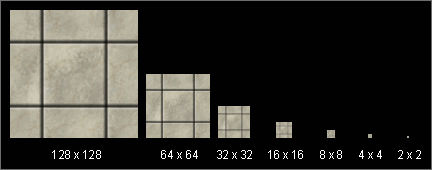This page contains information regarding textures.
Use Telltale Explorer. This part of the tutorial explains how to use it.
I mentioned that they are stored in TTARCH files, but you may have seen there are a lot. Let's see how to recognize what a particular archive stores. First, we separate the name by underscores ("_"). The first few words describe in what game it is used and where it is being used. Some of the game-related stuff are:
| Name | Description |
|---|---|
| Boot | These files are used during the boot process of the game. There are textures for loading screens or titles. |
| Menu | These files are used in the game's menu. There are textures for buttons, title screens, backgrounds and more. |
| Project | [WIP] |
| [GameName][3-digit number] | The files are used in a particular episode of a game. The first digit of the number represents the season, the latter 2 digits represent the episode number. |
| Other uncommon types | Usually for shaders, effects or localization-related files. |
Example 1: WalkingDead_pc_WalkingDead201_txmesh stores the textures for episode 1 of The Walking Dead Season 2. Example 2: WDC_pc_UISeasonM_txmesh contains UI textures for The Walking Dead Michonne in The Walking Dead Collection.
The last word describes what files are stored there. The texture related ones are stored in the following:
| Name | Description |
|---|---|
| txmesh |
|
| compressed |
|
| all |
|
Example: Most of the common textures for TWDS1 in TWD:DE are stored in ProjectSeason1_txmesh.ttarch2 archive.
There are other types or archives and Telltale types. Check out this page
This question is a complicated one and it depends on what the user wants. Let's answer some additional questions first.
There are a lot of types of textures. This article explains the main ones. Typically (unless you are an experienced texture artist) you would only really need to be modifying the diffuse textures.
Diffuse textures are just the raw material/model colors and these textures typically have no suffix after them in their file names like _spec, _ink, _detail, etc.
Sometimes you may not find the texture you are looking for. It may be stored in a different archive.
Telltale uses the following naming convention.
| First Prefix | Description |
|---|---|
| adv | Lightmaps. |
| color | Colors. |
| env (environment) | Environment textures, like for e.g. trees, ground, walls, etc. |
| fx (effect) | Effects. |
| gobo | Go-Betweens. Used for lighting. |
| lookup | Lookup textures. |
| normalxy | Normal maps, stored in BC5. They have 2 colors only. |
| obj | Objects. |
| sk[N] (skeletons) | Textures used on characters. The number represents the height of the skeleton. |
| tile | Repetitive texturing like floors, walls, roofs, etc. |
| ui (user interface) | UI (buttons, dialogs, etc.) |
These suffixes indicate and deal with other material properties.
| Suffix | Description |
|---|---|
| NONE | Diffuse texture. |
| detail | Bump/SDF map. Black lines of the material. |
| nm | Normal map. Note: Telltale have their normal map color channels reversed (ABGR instead of RGBA). |
| glow | Glow map. |
| spec | Specular texture. |
| ink | Black lines of the material. |
| sss | Subsurface Scattering. (Thanks Knollad!) |
| gradient | Gradients, probably used for shading. |
Note
Example: sk54_lee_head.d3dtx is a diffuse texture, while sk54_lee_head_spec.d3dtx is a specular texture.
A lot of textures have mips. They are basically lower resolution textures that are embedded in the file and are used at a distance in the game engine to prevent aliasing and artifacts.
Pixel data is not always stored in RGB or RGBA format as one would presume. There can be many different ways of storage for optimization purposes in order to save space. There are compressed and uncompressed formats, stored in different data types with different amount of channels.
This page has somewhat compact information if you are more interested. Check out this page for all available surface formats. Check out this file for more technical information of all available Telltale surface formats.
Textures can be 2D, Volumemaps (3D) Cubemaps, 2D Array or Cubemap array.
Telltale commonly use 2D. In rare cases - 2D Array or Cubemaps. Skunkcape have used volumemaps for lookups.
Here are some examples on how they should look like.
| 2D | Cubemap |
|---|---|
 |
 |
This page has somewhat compact information if you are more interested.
Take a small break. I suggest looking through it briefly.
In any case, Telltale mostly uses BC1, BC2, BC3, BC4 and BC5 compressed formats, and RGBA8, BGRA8 and A8 uncompressed formats.
As for texture layouts - 99.9% are 2D textures.
Check out this page for all available surface formats.
The Telltale Texture Tool provides Image Properties section, which reveals the most important information. Generally, try aiming for the same properties. Sometimes you can even change the surface format.
Check out this page to know in which format to save.
You can change the width, height, surface format and the mip count. We can technically make new textures with different layouts.
See this page to know which format to use depending on the texture type.
Caution
If the game crashes, that means the format is not supported for the game. An example being BC6H, which is not supported on older Telltale titles. Try different ones! The only one that works on all games is ARGB8 (or RGBA8).
